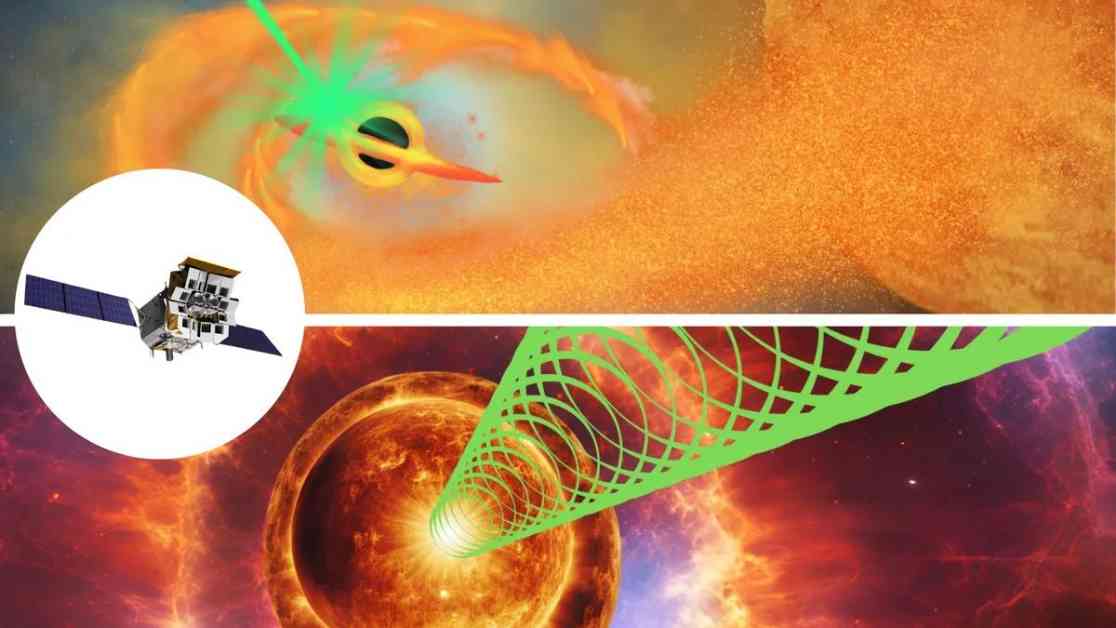A mysterious cosmic explosion detected by the Einstein Probe spacecraft has left astronomers puzzled and intrigued. In April of last year, the spacecraft captured a highly energetic explosion that defied conventional explanations. Initially thought to be a burst of gamma rays from the collision of neutron stars or the death of a massive star, the event, known as EP240408A, presented a new possibility – a supermassive black hole tearing apart and consuming a star in a phenomenon called a tidal disruption event (TDE).
The enigmatic nature of EP240408A prompted an international team of astronomers to conduct follow-up observations using a variety of ground and space-based telescopes, including NASA’s Nuclear Spectroscopic Telescope Array (NuSTAR) and Neutron star Interior Composition Explorer (NICER) instruments. The team’s efforts revealed that the explosion did not fit neatly into any existing cosmic event category, hinting at the potential discovery of a new astronomical phenomenon.
Brendan O’Connor, a researcher from Carnegie Mellon University and member of the international team, expressed the team’s excitement and uncertainty, stating, “EP240408A ticks some of the boxes for several different kinds of phenomena, but it doesn’t tick all the boxes for anything. In particular, the short duration and high luminosity are hard to explain in other scenarios. The alternative is that we are seeing something entirely new!”
Unraveling the Mystery of Jetted Tidal Disruption Events
Tidal disruption events (TDEs) occur when stars venture too close to supermassive black holes at the centers of galaxies. The immense gravitational pull of these black holes causes stars to be torn apart in a process known as spaghettification, where they are stretched and compressed by tidal forces. The resulting stellar debris forms an accretion disk around the black hole, gradually feeding the central object.
While most TDEs follow a similar pattern, jetted TDEs represent a rare and intriguing subset of these events, accounting for approximately 1% of all observed occurrences. The exact mechanisms behind jetted TDEs remain a subject of ongoing research and debate among astronomers.
In a separate study published in The Astrophysical Journal Letters in October 2023, researchers proposed that jetted TDEs may occur when there is a significant misalignment between the rotation axis of the supermassive black hole and the orbital plane of the engulfed star. This misalignment leads to the formation of powerful jets that distinguish jetted TDEs from other TDE variants.
Exploring the Cosmic Landscape with NASA’s NICER
The role of NASA’s NICER instrument in studying EP240408A highlights the importance of advanced technology in unraveling cosmic mysteries. NICER’s ability to observe and monitor various regions of the sky for extended periods has provided valuable insights into unusual cosmic phenomena, such as the enigmatic explosion detected by the Einstein Probe.
Dheeraj Pasham, a researcher from the Massachusetts Institute of Technology (MIT) and member of the international team, emphasized the significance of NICER’s capabilities in advancing our understanding of cosmic events. As astronomers continue to investigate EP240408A and similar phenomena, the Einstein Probe remains poised to capture even more intriguing discoveries.
“I’m excited to chase the next weird explosion from the Einstein Probe,” expressed Pasham, reflecting the team’s enthusiasm for uncovering new and unexpected cosmic phenomena. The team’s research, published in The Astrophysical Journal Letters on Jan. 27, represents a significant step towards expanding our knowledge of the universe and its many mysteries.










